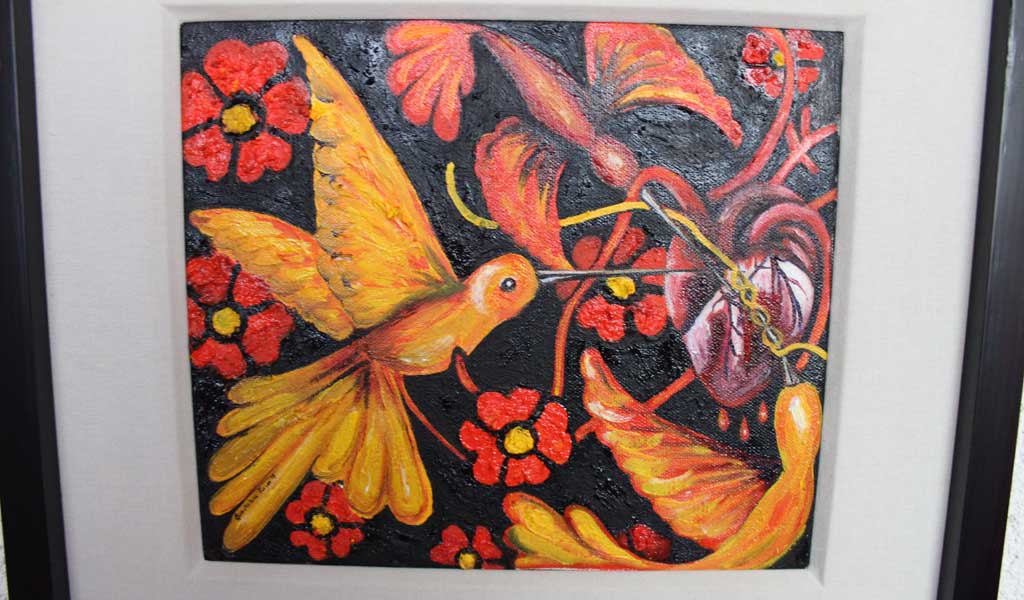In creating ‘Pasion de un Colibri’, the artist crafts visual representations applying dramatic structure as a storytelling method similar to productions for stage and film. The artist incorporates the dramatic arc found in playwriting, screenwriting and a various forms of literature-including the exposition, rising action, climax, falling action and denouement comprising Freytag’s theory of dramatic structure (MacEwan, 2007). The artist’s illustrations possessing elements of dramatic structure and cultural symbolism creates an inspiring collection of works with qualities across disciplines of visual art and literature. The artist features various strategies for creating the design within an exhibit of 11 works which symbolize the transformation of the human spirit through the metaphor of the hummingbird and the repairing of the wounded heart.

The collection functions as a passion play reflecting the resurrection of Christ and spiritual rebirth. Symbolic representations appear within each painting, giving the observer the opportunity to reflect upon the spiritual nature of the story and how it serves as a source of inspiration for individuals on their pursuit of a connection with spirituality.
Reencarnacion
Observers interpret the story through the juxtaposition of the heart’s condition with the metaphor of the hummingbird, the heart as representing the fragility of human nature, and the hummingbird as a metaphor representing life reborn and connection to the warrior spirit in Aztec culture-illustrating their subsequent union as transforming them into the new spirit.
YouTube video (beginning at 10 seconds)
El Principio
The first painting in the collection, ‘El Principio’, carries on the visual depictions of the heart in Las dos Fridas. In Kahlo’s work, the artist composes self-portraits which depicts juxtaposing perspectives of cultural expression by illustrating union and separation as a visual device (Friis, 2004). The portrait on the right symbolizes the artist’s true expression of self, while the image on the left reflects ideals of complacency. Equally as significant as the roles of expression and culture were the plight of the heart. Kahlo masterfully depicts the heart as the embodiment of the human experience, challenging its fervor by cutting the left portrait’s torn heart with surgical pincers. The poignant image remains a source of examination by critics for its impact on contemporary art. The heart in Pasion de un Colibri functions similarly to Kahlo’s art, expounding upon the concept by introducing the symbolism of the hummingbird, exemplifying its significance to Aztec culture and representation of life reborn.
Las dos Fridas
Abrazando un Corazon Herido
Abrazando un Corazon Herido functions as the climax in the dramatic structure, representing the highest point in the dramatic arc through the depiction of the embracing between two juxtaposing figures, which forms the visual basis for establishing the processes of reincarnation as the story’s falling action and El Final as denouement. Prior to the climax, the rising action appears in the tearing of the heart in El Duelo and its subsequent isolation in Zurciendo un Corazon and Zurciendo un Corazon 2. The hummingbird’s embracing of the heart perpetuates the spiraling of colors expressing the lifting and supporting of the heart in preparation for new life.
Possessing qualities across disciplines of visual art and literature, Pasion de un Colibri introduces audiences to an outstanding collection of paintings with an inspirational story. The artist recently completed a successful exhibit at Centro Historico de Zacatecas, and individual paintings from the collection are available for purchase.
Gallery impressions by writer Heraclio Castillo Velazquez:
“Small and fragile as the Hummingbird, love leads stasis to vertigo in a journey of colors and textures that open in beautiful ramadal. Beating up to thousand times per minute, the heart vibrates, shakes, excited and explodes at some point, becomes fragmented, creaks inside like a dry egg left in the nest.
The metaphor of the Hummingbird, a bird sacred to the Aztecs, is spilled on the canvas of Guadalupe Reyes to offer us a dramatic mosaic where the heart opens to the existence of love on a shy flight, with the color of life trapped between the wings and the petals of the flower.
But the heart, although free, our most human part, with the risk of losing the flight on the first sore. So, how darning a wound of love?
Guadalupe Reyes leads the hand in this process in which life is reborn as the Hummingbird, once a warrior heart that gave the best of themselves and in their transformation unites parts that left love to create a new “Me”: this bird of a thousand colors on his flight to life.”
References
MacEwan, E. (2009). Freytag’s Technique of the Drama. Charleston: BiblioLabs LLC.
Friis, R. (2004). “The Fury and the Mire of Human Veins”: Frida Kahlo and Rosario Castellanos. Hispania, 87(1), 53-61.


